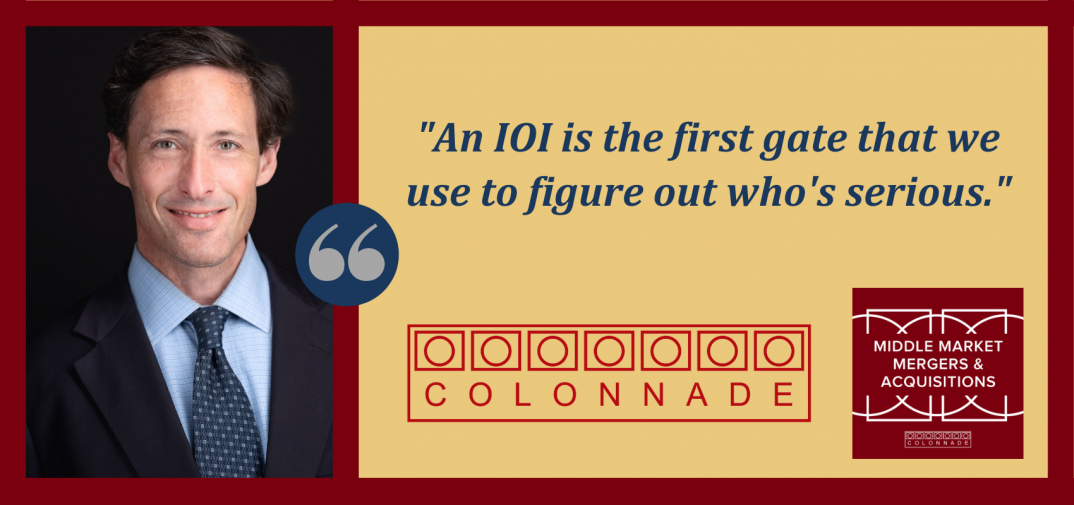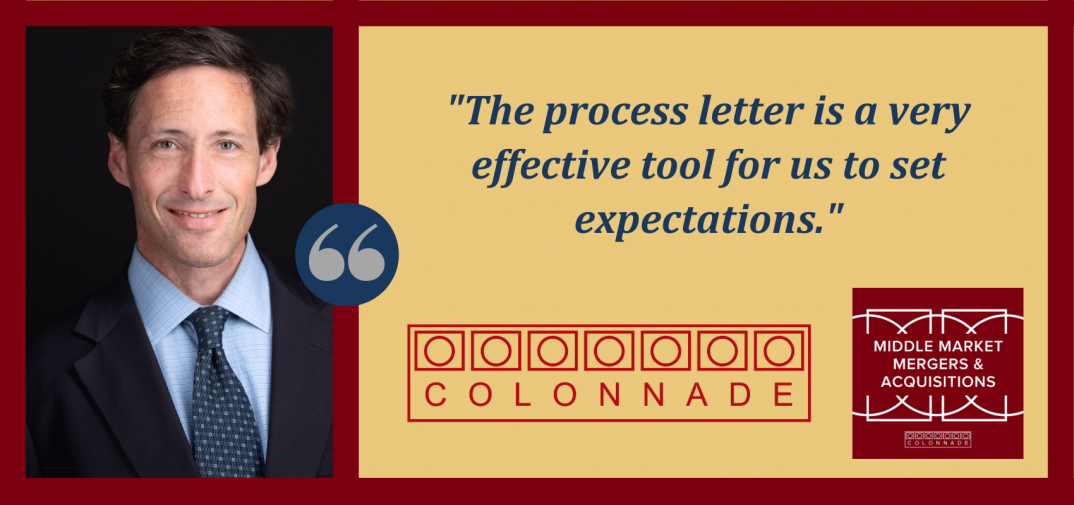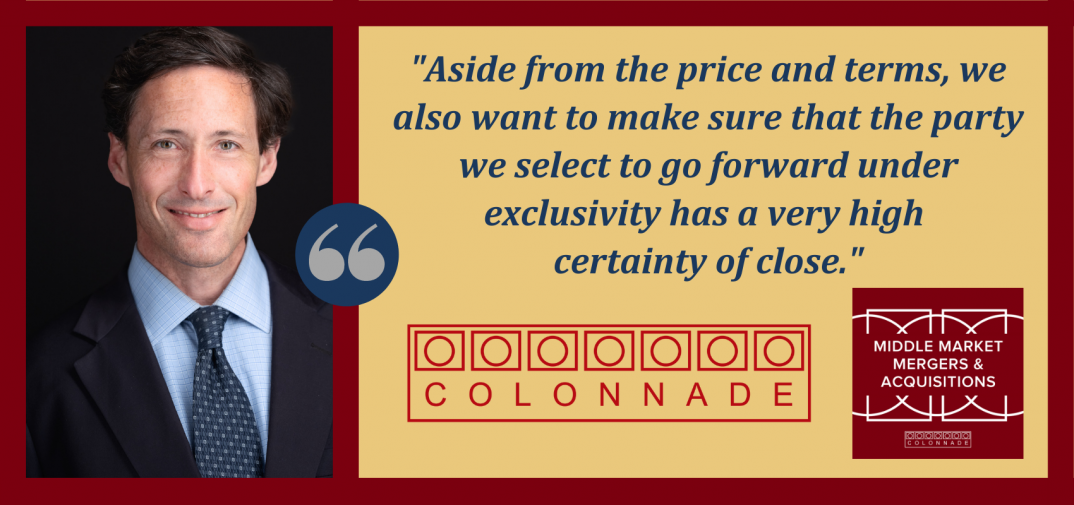In previous episodes, Colonnade Advisors has outlined our unique 16-week sales process timeline in four phases: pre-marketing, go to market, management presentations/buyer due diligence, and exclusivity/documentation. In this episode, we will be doing a deep dive on indications of interest (“IOI”), which take place at the end of the go to market phase, and letters of intent (“LOI”), which take place at the end of the management presentations/buyer due diligence phase.

IOI and LOI serve as two gates:
- When we are nearing the end of the marketing phase, we ask for IOIs, which serve as an initial gate that helps us weed out the tire kickers and narrow the field as to who should have the opportunity to meet with the management team and dig into the opportunity.
- After the management meeting and once potential buyers have completed their initial due diligence, we ask for an LOI. The LOI is the guiding document that is going to drive the final documentation. Therefore, we must get as much information at this point in the process to understand what a transaction is going to look like and how we will get it done. In that way, our clients can make the best-informed decisions about how to proceed and the likelihood and certainty of close.
In this episode, we answer the following questions:
- What are IOIs and LOIs?
- What are the timelines and milestones with IOIs and LOIs?
- What is in each of these letters, and why are they so important?
- How do we use these letters to vet bidders and drive competition in the process?
What are IOIs and LOIs? (00:45)
Jeff: IOIs and LOIs are written letters that we request from potential buyers. These letters are two critical steps in evaluating interest among potential bidders and the financial details of a proposed transaction. In addition, IOIs helps us narrow the field as we end the marketing phase and help to determine the party our client selects to enter the exclusivity and documentation phase.
At what point during the sale process do you request IOIs and LOIs from potential acquirers? (01:05)
Jeff: These letters come about midway during our process with our seller clients. At this point, we have already completed the upfront due diligence, written the confidential information memorandum, and put together the financial model. Also, we have talked to a large universe of vetted buyers and investors and distributed the CIM. We ask for the letters about two or three weeks after interested buyers get the CIM.

What is the primary purpose of the IOI and LOI? (02:50)
Jeff: An IOI is the first gate that we use to figure out who’s serious. We ask interested buyers to put pen to paper and follow a format that we send out in a process letter and tell us what they think this business is worth, why they are a suitable buyer, and what a transaction might look like.
Gina: The IOI is a good way to weed out tire kickers because they have to make some effort to write an IOI. Also, we get a price on the table, and we can determine, based on the price and the terms proposed, who is really serious. Importantly, it is our first opportunity to negotiate on price and terms with the buyers. We also now have a market read on what parties think the company is worth.
What is a process letter? (04:50)
Gina: In the process letter, we give instructions to potential bidders as to what is needed in the IOI. We tend to send the process letter out after buyers receive the confidential information memorandum because it is an opportunity for us to have another formal contact with the bidder and give us early feedback.

Jeff: The process letter is a very effective tool for us to set expectations. We are setting a competitive dynamic by calling for bids on a specific date, outlining that management meetings will be available to those chosen to proceed in the process, and setting the timeline for the transaction.
What is in the process letter for an IOI? (06:33)
Gina: First and foremost, we are going to ask what the purchase price is. We will tell interested parties what they will be bidding off of. Typically, in an IOI, we will get a range from potential bidders. Another thing that we’ll ask for is what exactly they are purchasing (equity or assets of the company). We will also ask about senior management reinvestment or rollover equity. Ideally, we would also like to see a source and uses capitalization table at the IOI phase. We want to see a commitment to reps and warranty insurance. It is great to see the bidder’s commitment to paying for the premium, the retention, and the underwriting, which helps strengthen their bid.
Jeff: Another item that we ask about is governance – how does the buyer envision running the company after a transaction. We want to get an early read on how potential bidders are looking at these deals.

Why is it important to understand the sources of financing from potential bidders? (12:41)
Gina: For sizeable private equity firms, sources of financing are not an issue because we know they have the capital. Other private equity firms may not have a dedicated fund or may have a partially dedicated fund and rely upon their co-investors. In these instances, we need to understand where the money is coming from.
How are IOIs typically structured? (15:38)
Jeff: Most of these letters that we receive typically start with introducing the strategic buyer or the private equity firm, some of their relevant investments, and their experience in the sector. It’s an opportunity for each bidder to demonstrate their strength and capabilities in this sector and presumably their seriousness in pursuing this transaction.
How do you, as the sell side advisor, evaluate IOIs? (16:50)
Jeff: We generally find that private equity firms are more inclined to take CIMs because their job is to review deals. Strategics often take longer to review the teaser and have discussions with us before they commit to signing an NDA. We put a little more weight into the strategic proposals because they have probably vetted this one or two levels higher in their organization, and this letter might carry a bit more weight.
Gina: After we receive all the bids, we review them, call bidders with questions, and we start negotiating. We negotiate to get everybody to put their best foot forward.

What is the next step after IOIs are vetted? (19:00)
Gina: Once we feel that we have all the bidders’ best effort, we will work with the management team to go through all the terms. Ultimately, the business owners will decide who they would like to move forward with into the next phase of the sale process, which is opening up the electronic data room, doing the management meetings, providing deeper diligence, and building up to the letter of intent.
Jeff: We spend a lot of time digging through these letters and talking through them with our clients to make sure that we bring the best group to the next phase. There are usually some outliers that we kick out. Still, we try to bring back as many potential acquirers into the next round as we can to maximize competition while balancing management’s time and any confidentiality issues.
What happens after the management meetings? (21:04)
Gina: Once we get through management meetings, we will distribute another process letter for the LOI phase. Usually, the time between IOI and LOI is about four weeks.
What is the difference between the IOI and LOI process letters? (22:00)
Gina: The LOI process letter looks pretty similar to the IOI process letter. We may have further details that we want to see, but what’s important is to clarify items that may have been vague in the IOI; so, we need to have great detail in the LOI phase.
How do you, as the sell side advisor, evaluate LOIs? (23:06)
Gina: Aside from price and general terms, there are several key items we focus on. The sources and uses capitalization table is an important component. Also, we will look for information on the non-competes. We also want to see detail on any earn out components because if there is an earn out, it is essential for us, at this stage, to negotiate the terms. There is a lot of negotiations in the LOI phase.
Jeff: When we get to the LOI phase, we look for final bids from potential buyers, so we want the LOIs to be as detailed as possible. Our job is to negotiate the highest price and the best terms along the way and compare these different proposals for our clients so they can make an informed decision. Aside from the price and terms, we also want to make sure that the party we select to go forward under exclusivity has a very high certainty of close.

When should the draft purchase agreement be distributed? (28:05)
Jeff: We encourage our seller clients to draft and distribute the purchase agreement to potential buyers during the third phase in our process, diligence and management meetings, which serves many purposes. It’s telling to see which bidders have engaged counsel and spent the time and money marking up that document as part of their LOI submission.
How long does it take to sign the LOI and move into exclusivity? (29:50)
Gina: From the day LOIs are due until we sign the LOI and move into exclusivity can take anywhere from five days to two weeks. It is not a bad sign if it takes longer. It just means that we have been negotiating to get the best possible deal for our clients and ironing out all these important details ahead of going exclusive with one party.





